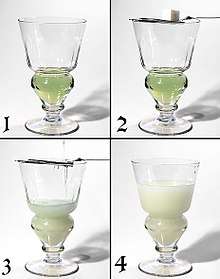Ouzo effect
The ouzo effect (also louche or spontaneous emulsification) is a cloudy (louche) oil-in-water emulsion that is formed when water is added to ouzo and other anise-flavored liqueurs and spirits, such as absinthe, arak, limoncello, pastis, rakı, sambuca, and tsipouro. Such microemulsions occur with only minimal mixing and are highly stable.[1]

Observation and explanation

The ouzo effect occurs when a strongly hydrophobic essential oil (such as trans-anethole) is dissolved in a water-miscible solvent (such as ethanol), and the concentration of ethanol is lowered either by addition of small amounts of water [2] or by evaporation of ethanol.[3]
Oil-in-water emulsions are not normally stable. Oil droplets coalesce until complete phase separation is achieved at macroscopic levels. Addition of a small amount of surfactant or the application of high shear rates (strong stirring) can stabilize the oil droplets. In a water-rich ouzo mixture the droplet coalescence is dramatically slowed without mechanical agitation, dispersing agents, or surfactants. It forms a stable homogeneous fluid dispersion by liquid-liquid nucleation.[4]
The size of the droplets has been measured by small-angle neutron scattering to be on the order of a micron.[5] Smaller droplets, in order of 100 nanometers, were found in Limoncello.[6]
Using dynamic light scattering, Sitnikova, et al.,[1] showed that the droplets of oil in the emulsion grow by Ostwald ripening, and that droplets do not coalesce. The Ostwald ripening rate is observed to diminish with increasing ethanol concentrations until the droplets stabilize in size with an average diameter of 3microns.
Based on thermodynamic considerations of the multi-component mixture, the emulsion derives its stability from trapping between the binodal and spinodal curves in the phase diagram.[5] However, the microscopic mechanisms responsible for the observed slowing of Ostwald ripening rates at increasing ethanol concentrations appear not fully understood.
Applications
The ouzo effect is seen as a potential mechanism for generating surfactant-free microemulsions without the need for high-shear stabilisation techniques that are costly in large-scale production processes. Emulsions have many commercial uses. A large range of prepared food products, detergents, and body-care products take the form of emulsions that are required to be stable over a long period of time. The creation of a variety of dispersions such as pseudolatexes, silicone emulsions, and biodegradable polymeric nanocapsules, have been synthesized using the ouzo effect, though as stated previously, the exact mechanism of this effect remains unclear.[7]
References
- Sitnikova, Natalia L.; Rudolf Sprik; Gerard Wegdam & Erika Eiser (2005). "Spontaneously Formed trans-Anethol/Water/Alcohol Emulsions: Mechanism of Formation and Stability" (PDF). Langmuir. 21 (16): 7083–7089. doi:10.1021/la046816l. PMID 16042427. Archived from the original (PDF) on 2009-03-18. Retrieved 2007-01-29.
- Sanchez-Dominguez, M.; Rodriguez-Abreu, C. (2016). Nanocolloids: A Meeting Point for Scientists and Technologists. Elsevier Science. p. 369. ISBN 978-0-12-801758-6. Retrieved 2 August 2018.
O/W and W/O nano-emulsions can also be formed without a surfactant by self-emulsification, using the so-called Ouzo effect. The major components of Ouzo (a Greek drink) are trans-anethole, ethanol, and water. Anethole is almost insoluble ...
- Tan, Huanshu; Christian Diddens; Pengyu Lv; Johannes GM Kuerten; Xuehua Zhang; Detlef Lohse (August 2016). "Evaporation-triggered microdroplet nucleation and the four life phases of an evaporating Ouzo drop". Proceedings of the National Academy of Sciences. 113 (31): 8642–8647. doi:10.1073/pnas.1602260113.
- Vitale, Stephen A.; Joseph L. Katz (May 2003). "Liquid Droplet Dispersions Formed by Homogeneous Liquid-Liquid Nucleation: The Ouzo Effect". Langmuir. 19 (10): 4105–4110. doi:10.1021/la026842o.
- Grillo, Isabelle (September 2003). "Small-angle neutron scattering study of a world-wide known emulsion: Le Pastis" (PDF). Colloids and Surfaces A, Physicochemical and Engineering Aspects. 225 (1–3): 153–160. doi:10.1016/S0927-7757(03)00331-5. Archived from the original (PDF) on 2006-11-27. Retrieved 2007-01-29.
- Chiappisi, Leonardo; Grillo, Isabelle (2018). "Looking into Limoncello: The Structure of the Italian Liquor Revealed by Small-Angle Neutron Scattering". ACS Omega. 3 (11): 15407–15415. doi:10.1021/acsomega.8b01858.
- Ganachaud, François; Joseph L. Katz (2005). "Nanoparticles and Nanocapsules Created Using the Ouzo Effect: Spontaneous Emulsification as an Alternative to Ultrasonic and High-Shear Devices". ChemPhysChem. 6 (2): 209–216. doi:10.1002/cphc.200400527. PMID 15751338.
External links
![]()